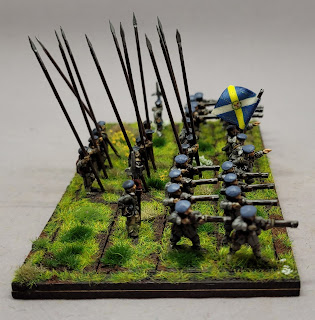Sir Allen Apsley's Regiment of Foot
The very last of my Royalist Regiments of Foot - that's a total of seventeen pike and shot, and three commanded shot (650 men in case you were wondering). But we've heard that before, so we'll settle on 'last' for the moment. Although... I have just learned that Sir Beville Grenville's Regiment of Foot had blue and white painted pikes and musket rests...
Raised in 1643 in Devon, the Regiment served in the West Country and with the King's Oxford Army throughout the First Civil War.
Sir Allen was born on 28th August 1616, the eldest son of Sir Allen (1567-1630), Lieutenant of the Tower of London, and his third wife Lucy (St John). Apparently Sir Allen Snr was so well loved by the Tower's inmates (often lending them money) that many didn't wish to leave their accommodation (that's not a euphemism, they genuinely didn't want to leave as he treated them so well). But I digress...
His sister was Lucy Hutchinson who married Colonel John Hutchinson. Hutchinson was one of the signatories of King Charles's death warrant, but he later protested against the assumption of supreme power by Oliver Cromwell.
After the Restoration of the monarchy in 1660, Hutchinson was arrested for his part in the regicide and imprisoned in Sandown Castle, Kent. However, he was not tried. Lucy went before the House of Lords to gain his release, but to no avail. In 1664, John Hutchinson died in prison.
The Regiment took part in the siege of Wardour Castle; garrisoned Winchester; took Axminster; fought at Cheriton; were present at the siege of Lyme; Cropredy Bridge; Lostwithiel; Second Newbury; garrisoned Cirencester; were possibly at the sieges of Plymouth and Taunton; stormed Leicester; Naseby; Langport; garrisoned Barnstaple; were possibly at the relief of Dunster Castle; then disbanded at the surrender of Barnstaple in April 1646.
Some time in 1644 Sir Edward Hopton took command of the Regiment - he was certainly in command of the Regiment from the storm of Leicester onwards.
Richard Symonds noted that the Regiment were wearing red coats at the Aldbourne Chase muster in April 1644, he also described their flags. I've gone for the 1st Captain's colour, as if there is a possibility of fielding a gyronny flag it has to be taken.
A number of headswaps, most notably my aversion to morion helmets rears its ugly head again.
Allen, Alan, or Alen? Apseley or Apsely? All used, so take your pick: I'm going with Allen Apsley (as that is what is carved upon his tomb in the south ambulatory of Westminster Abbey).
Sir Allen was born on 28th August 1616, the eldest son of Sir Allen (1567-1630), Lieutenant of the Tower of London, and his third wife Lucy (St John). Apparently Sir Allen Snr was so well loved by the Tower's inmates (often lending them money) that many didn't wish to leave their accommodation (that's not a euphemism, they genuinely didn't want to leave as he treated them so well). But I digress...
Upon the restoration, Apsley (Jnr) was made Master of the Privy Hawks (or Falconer) in 1660 and keeper of the North Park of Hampton Court in 1661.He was a member of the household of James, Duke of York (later James II) and served as Member of Parliament for Thetford in Norfolk.
His sister was Lucy Hutchinson who married Colonel John Hutchinson. Hutchinson was one of the signatories of King Charles's death warrant, but he later protested against the assumption of supreme power by Oliver Cromwell.
After the Restoration of the monarchy in 1660, Hutchinson was arrested for his part in the regicide and imprisoned in Sandown Castle, Kent. However, he was not tried. Lucy went before the House of Lords to gain his release, but to no avail. In 1664, John Hutchinson died in prison.
The Regiment took part in the siege of Wardour Castle; garrisoned Winchester; took Axminster; fought at Cheriton; were present at the siege of Lyme; Cropredy Bridge; Lostwithiel; Second Newbury; garrisoned Cirencester; were possibly at the sieges of Plymouth and Taunton; stormed Leicester; Naseby; Langport; garrisoned Barnstaple; were possibly at the relief of Dunster Castle; then disbanded at the surrender of Barnstaple in April 1646.
Some time in 1644 Sir Edward Hopton took command of the Regiment - he was certainly in command of the Regiment from the storm of Leicester onwards.
Richard Symonds noted that the Regiment were wearing red coats at the Aldbourne Chase muster in April 1644, he also described their flags. I've gone for the 1st Captain's colour, as if there is a possibility of fielding a gyronny flag it has to be taken.
A number of headswaps, most notably my aversion to morion helmets rears its ugly head again.
Thanks.















Comments
Post a Comment